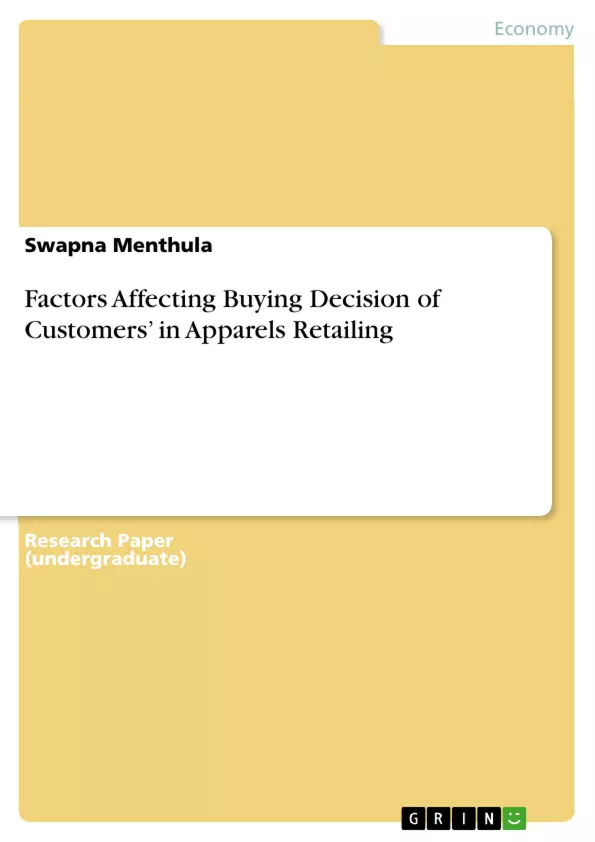In India retail industry is the largest among all the industries, the retail industry is upgrading itself providing with endless array for customer choices like changing life style, customers brand awareness depending on income level of customers. The retail industry in India is hailed as a sunrise sector and the value is estimated to increase from US $330 billion in 2007 to US$640 billion by 2015 i.e., almost double the value. The size of India's retail sector is currently estimated at around $450 billion and organized retail accounts for around 5% of the total market.
We cannot take customers for granted because consumer buying behavior determines how consumer decides which product to buy and what all factors are responsible for the buying decision. The firm has to satisfy the needs and wants of a consumer.
Hence the present study has been conducted to understand the impact of various factors viz. physical attributes, display, merchandise, sales people, and overall quality of store on customers' buying decision in Apparel Retailing.
Table of Contents
- 1. INTRODUCTION
- 2. LITERATURE REVIEW
- 3. RESEARCH METHODOLOGY
- 4. DATA ANALYSIS AND INTERPRETATION
- 5. FINDINGS AND CONCLUSIONS
Objectives and Key Themes
This study aims to understand the overall shopping experience of apparel customers and the factors influencing their buying decisions. It also explores the relationship between demographic variables (gender, age, income, marital status) and overall shopping experience quality.
- Factors influencing consumer buying decisions in apparel retailing.
- The role of demographics in shaping shopping behavior.
- Analysis of different theoretical perspectives on consumer decision-making.
- The impact of shopping experience on customer satisfaction.
- Comparison of organized and unorganized retail sectors in India.
Chapter Summaries
1. INTRODUCTION: This introductory chapter sets the stage for the study by highlighting the dynamic nature of India's retail industry, emphasizing the shift from unorganized to organized retail and the growing competition within the apparel sector. It underscores the importance of understanding consumer behavior to gain a competitive advantage and justifies the need for research into the factors influencing customer buying decisions. The chapter establishes the context and the research objectives of the study, emphasizing the significance of consumer satisfaction and the influence of various demographic variables.
2. LITERATURE REVIEW: This chapter reviews existing literature on consumer buying behavior, drawing on several sources to present various theoretical perspectives. It examines the distinction between needs and wants, the steps involved in consumer decision-making, and various models of buying behavior (e.g., economic, passive, emotional, cognitive views). The chapter explores different roles consumers play in the purchasing process (initiator, influencer, decider, buyer, user) and different types of buying behavior (complex, reducing, habitual, variety-seeking). The review provides a theoretical foundation for the study, framing the research questions within established academic discourse and identifying key variables for investigation.
Keywords
Consumer buying behavior, apparel retailing, India, organized retail, unorganized retail, demographic variables, shopping experience, consumer satisfaction, decision-making process, needs, wants, marketing.
Frequently Asked Questions: Comprehensive Language Preview of Apparel Customer Shopping Experiences in India
What is the overall topic of this study?
This study focuses on understanding the apparel shopping experiences of customers in India and the factors influencing their buying decisions. It particularly investigates the relationship between demographic factors (age, gender, income, marital status) and the overall quality of the shopping experience.
What are the main objectives of this research?
The study aims to identify factors influencing consumer buying decisions in apparel retail, analyze the role of demographics in shaping shopping behavior, explore relevant theoretical perspectives on consumer decision-making, assess the impact of shopping experience on customer satisfaction, and compare organized and unorganized retail sectors in India.
What are the key themes explored in this research?
Key themes include consumer buying behavior in the context of India's apparel retail market, the influence of demographic variables on purchasing decisions, the comparison between organized and unorganized retail sectors, and the impact of the shopping experience on customer satisfaction. Theoretical perspectives on consumer decision-making are also explored.
What is covered in the Literature Review chapter?
The literature review examines existing research on consumer buying behavior, presenting different theoretical viewpoints. It differentiates between needs and wants, details the steps in consumer decision-making, and explores various models of buying behavior (economic, passive, emotional, cognitive). It also addresses the different roles consumers play in purchasing and various types of buying behavior (complex, reducing, habitual, variety-seeking).
What is the focus of the Introduction chapter?
The introduction sets the context by describing the dynamic Indian retail industry, highlighting the shift towards organized retail and the increased competition in the apparel sector. It emphasizes the importance of understanding consumer behavior for competitive advantage and justifies the research by focusing on the factors influencing buying decisions, consumer satisfaction, and demographic influences.
What kind of data analysis is likely included? (Inferred from the structure)
While not explicitly detailed, a chapter on Data Analysis and Interpretation suggests that the study will involve statistical analysis of collected data to support the findings and conclusions.
What are the likely findings and conclusions? (Inferred from the structure)
The study will likely present findings on the significant factors affecting apparel purchasing decisions in India, the role of demographics, and a comparison between organized and unorganized retail. The conclusions will summarize the key insights and their implications for the apparel retail industry.
What are the key words associated with this study?
Key words include consumer buying behavior, apparel retailing, India, organized retail, unorganized retail, demographic variables, shopping experience, consumer satisfaction, decision-making process, needs, wants, and marketing.
What is the structure of the provided document?
The document provides a preview including a table of contents, objectives and key themes, chapter summaries, and keywords. This allows for a comprehensive overview of the research without detailing the full analysis and results.
- Citar trabajo
- Swapna Menthula (Autor), 2012, Factors Affecting Buying Decision of Customers’ in Apparels Retailing, Múnich, GRIN Verlag, https://www.grin.com/document/207808



